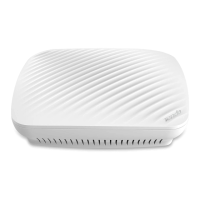63
It specifies the threshold of a fragment. The unit is byte.
Fragmenting is a process that divides a frame into several fragments, which are
transmitted and acknowledged separately. If the size of a frame exceeds this
threshold, the frame is fragmented.
In case of a high error rate, you can reduce the threshold to enable the AP to
resend only the fragments that have not been sent successfully, so as to increase
the frame throughput.
In an environment without interference, you can increase the threshold to reduce
the number of acknowledgement times, so as to increase the frame throughput.
It specifies the frame length threshold for triggering the RTS/CTS mechanism.
If a frame exceeds this threshold, the RTS/CTS mechanism is triggered to reduce
conflicts. The unit is byte.
Set the RTS threshold based on the actual situation. An excessively small value
increases the RTS frame transmission frequency and bandwidth requirement. A
higher RTS frame transmission frequency enables a wireless network to recover
from conflicts quicker. For a wireless network with high user density, you can
reduce this threshold for reducing conflicts.
The RTS mechanism requires some network bandwidth. Therefore, it is triggered
only when frames exceed this threshold.
It specifies the interval for transmitting the Delivery Traffic Indication Message
(DTIM) frame. The unit is Beacon.
A countdown starts from this value. The AP transmits broadcast and multicast
frames in its cache only when the countdown reaches zero.
For example, if DTIM Interval is set to 1, the AP transmits all cached frames after
each beacon frame is transmitted.
It specifies the minimum strength of received signals acceptable to the AP. If the
strength of the signals transmitted by a wireless device is weaker than this
threshold, the wireless device cannot connect to the AP.
If there are multiple APs, an appropriate value of this parameter ensures that
wireless clients connect to the APs with strong signals.
Interference mitigation mode. The default is 2.
0: Disable all interference mitigation.
1: Enable interference mitigation from the same frequency band, like
interference from microwave oven, smartphone, or Bluetooth device.
2: Compulsively enable radio waves interference mitigation.
3: Automatically enable radio waves interference mitigation.
It specifies the transmit power of the AP. Higher transmitted power contributes to
wider wireless coverage. But reducing the transmitted power properly can
improve the security of your wireless network.

